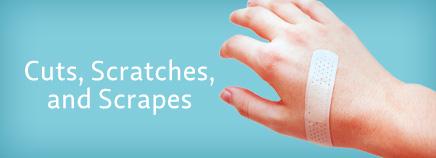Everyday life comes with its fair share of accidents, and Cuts & Scrapes are among the most common injuries people experience. Whether from kitchen mishaps, sports activities, or outdoor work, these minor wounds may seem harmless at first glance. However, some injuries require more than simple home care to avoid complications such as infection or delayed healing. At First Care Family Clinic, patients receive comprehensive wound evaluation and treatment designed to support safe, quick, and effective recovery.
Understanding Cuts & Scrapes
Cuts and scrapes are injuries to the skin, the body’s protective barrier. While many heal on their own with proper care, untreated wounds can allow bacteria to enter the body, leading to infections or other health risks.
-
Cuts (lacerations): These are deeper injuries caused by sharp objects like knives or glass.
-
Scrapes (abrasions): These occur when the skin rubs against a rough surface, often causing shallow damage.
Common Causes of Cuts & Scrapes
Everyday Activities
Cooking, shaving, or handling sharp tools can result in accidental cuts. Children are particularly prone to scrapes while playing outdoors.
Sports and Exercise
Contact sports, cycling, and running increase the risk of falls, leading to abrasions and lacerations.
Workplace Incidents
Jobs involving heavy equipment, construction, or machinery often contribute to accidental injuries.
Outdoor Adventures
Camping, hiking, or gardening can expose individuals to rough surfaces, increasing the risk of scrapes.
Symptoms to Watch For
While most Cuts & Scrapes cause mild pain and bleeding, some symptoms suggest more serious issues:
-
Excessive bleeding that doesn’t stop after 10 minutes of pressure.
-
Deep wounds that expose fat or muscle tissue.
-
Signs of infection: redness, swelling, warmth, pus, or fever.
-
Numbness near the wound, which may suggest nerve damage.
First Aid for Cuts & Scrapes
Proper first aid can prevent infection and support faster healing. Follow these steps:
-
Wash Your Hands: Prevent bacteria from spreading to the wound.
-
Stop the Bleeding: Apply gentle pressure with a clean cloth or bandage.
-
Clean the Wound: Rinse under running water to remove dirt and debris. Avoid using harsh chemicals like hydrogen peroxide, which can damage tissue.
-
Apply Antibiotic Ointment: Helps reduce infection risk.
-
Cover the Wound: Use sterile bandages or dressings, especially for deeper cuts.
-
Change Dressings: Replace bandages daily or when they become wet or dirty.
When to Seek Medical Help
Not all wounds can be safely managed at home. Seek professional care if:
-
The cut is deeper than half an inch.
-
Bleeding persists despite applying pressure.
-
The wound edges are jagged and may require stitches.
-
Foreign objects (like glass or dirt) remain embedded.
-
The injury is near the eye or on the face, where scarring is a concern.
-
The patient hasn’t had a tetanus shot in the last 5 years.
Complications of Untreated Cuts & Scrapes
Ignoring wound care can lead to complications, such as:
-
Infections: Causing redness, pus, fever, or swelling.
-
Delayed Healing: Especially in patients with diabetes or poor circulation.
-
Scarring: Improperly treated wounds may leave visible scars.
-
Cellulitis: A potentially serious bacterial skin infection.
Medical Treatments for Cuts & Scrapes
At a clinic, wound care may involve:
-
Stitches or Staples: To close deep cuts.
-
Tetanus Shots: If the wound is caused by rusted or dirty objects.
-
Antibiotics: For infected or high-risk wounds.
-
Wound Debridement: Removal of dirt, dead tissue, or debris.
-
Specialized Dressings: Designed to speed healing and reduce scarring.
Preventing Cuts & Scrapes
Prevention plays a key role in reducing injury risks:
-
Wear protective gear during sports or heavy work.
-
Use tools and equipment safely.
-
Keep sharp objects stored securely.
-
Teach children safe play practices.
-
Keep skin moisturized to prevent cracks that may worsen with injuries.
Cuts & Scrapes in Children
Children frequently experience scrapes due to active play. Parents should clean the wound immediately and monitor for infection. If the wound is large, won’t stop bleeding, or looks infected, medical care is necessary.
Cuts & Scrapes in Older Adults
Healing slows with age, making wound care especially important for seniors. Even minor cuts may take longer to heal, and underlying conditions like diabetes can increase infection risk.
Emotional and Social Impact
Beyond physical discomfort, visible wounds may affect confidence and social interactions, especially when scarring occurs. Prompt and proper care not only protects health but also helps preserve appearance and comfort.
Best Practices for Wound Healing
-
Eat a nutrient-rich diet with vitamins C and E for skin repair.
-
Stay hydrated to promote cellular healing.
-
Avoid smoking, as it slows wound recovery.
-
Follow medical instructions for dressing changes and care.
Conclusion
Cuts & Scrapes may seem like minor injuries, but neglecting them can lead to infection, scarring, or long-term complications. Knowing when to seek medical care is crucial for safe recovery. At First Care Family Clinic, patients benefit from expert wound assessment, advanced treatments, and compassionate care that supports healing and reduces risks. By addressing cuts and scrapes promptly and properly, individuals can maintain both their health and quality of life.
FAQs
Q1: Can I use alcohol or hydrogen peroxide to clean cuts?
It’s best to avoid these as they may irritate tissue. Clean water is usually sufficient.
Q2: How long should I keep a bandage on a scrape?
Keep it covered until the wound starts healing and no longer risks infection.
Q3: What should I do if a cut leaves a scar?
Use scar-reducing creams or consult a professional for advanced treatments.
Q4: Can children get tetanus from cuts?
Yes. Ensure vaccinations are up-to-date, especially after injuries involving rusty or dirty objects.
Q5: Are stitches always required for deep cuts?
Not always, but any cut that doesn’t close on its own should be evaluated.



